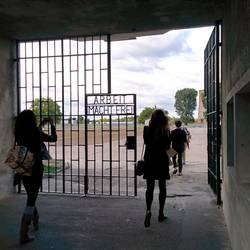- Show trip
- Add to bucket listRemove from bucket list
- Share
- Sep 20, 2023
- ⛅ 24 °C
- Altitude: 40 m
 GermanyBrandenburgOranienburg52°45’49” N 13°15’37” E
GermanyBrandenburgOranienburg52°45’49” N 13°15’37” E
Berlin
 September 20, 2023 in Germany ⋅ ⛅ 24 °C
September 20, 2023 in Germany ⋅ ⛅ 24 °C
We got up a bit earlier today for a very confronting but important tour to the former Sachsenhausen concentration camp. Although this was a hard day, we think it's really important to learn about these parts of history and remember the victims of the horrors of the past.
We met our tour guide (who happened to be an Aussie studying history in Berlin) at a nearby train station and made our way out to Sachsenhausen on two trains and a bus. The trip took about an hour and he explained a few things about concentration camps including the history of the Nazi party's rise to power following WWI. Germany was born out of militaristic origins and so when they experienced huge losses in WWI, the party blamed Germany's loss and economic position on the Jews (using them as a scape goat). Once the Great Depression happened there were 6 million unemployed Germans and so these people sought support in the Nazi party which grew to the largest party in Germany.
Our guide went into detail of Hilter's rise to power and the background in Germany. Specifically in relation to concentration camps, they were first constructed as a means to imprison political prisoners or opposers to the Nazi regime, and as history has shown were used for other means. There were over 44,000 concentration camps during the Holocaust. Sachsenhausen concentration camp started as a working/forced labour camp and the majority of the prisoners were imprisoned due to their political beliefs (though there was a large population which were imprisoned due to their status as Jews). It was the first concentration camp and was seen as a "model" for other camps. The violence at the camp increased over time as it became overpopulated and mass murders occurred in the 1940s at the camp through the use of the "neck shot unit" and later the gas chambers.
We don’t need to go into the detail of what we saw in the camp but it is certainly very moving. There are replicas of some of the barracks as well as the original foundations/remains of other buildings and the gas chambers at station Z. The old camp kitchen has been converted into the main exhibit where different artefacts and stories of the camp are displayed and the way that the Nazi's horrific methods of mass murder evolved over time.
Some may question why the camp has been restored, and this is summed up in an important quote by one of the survivors of the camp which says:
"And I know one thing more - that the Europe of the future cannot exist without commemorating all those, regardless of their nationality, who were killed at that time with complete contempt and hate, and who were tortured to death, starved, gassed, incinerated and hanged..."
After our tour, we boarded the bus and train together as a group back to Berlin and arrived back at the hostel around 4pm. We then decided to stay at the hostel for the rest of the afternoon.
Later, we headed out for pizza and beer for dinner - the waiter only spoke Italian so Daniel was forced to draw on his Italian to order dinner. Thankfully two pizzas and two beers is pretty easy to work out!Read more








































































































Traveler Wow this would have been hard to. Just looking at the photos gave me great sadness. 😔